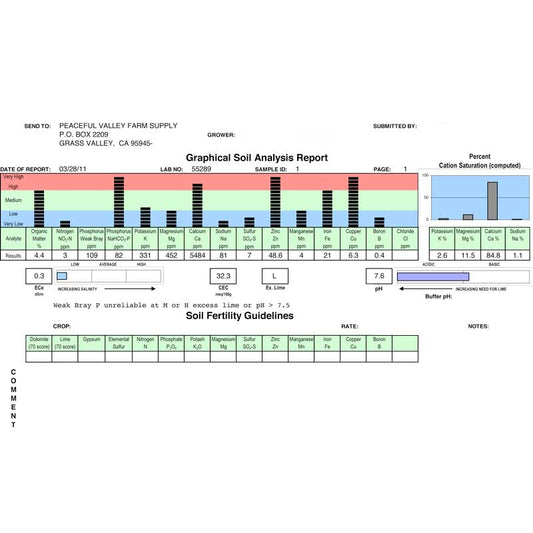Understanding Your Soil Test Results
It all begins with the soil! Knowing the make up of your soil is key to growing good vegetables, fruit trees and berries. Part 1–Reading Your Analysis talked a lot about the terms and definitions on the soil analysis report and it is a good idea to read the article before getting into Part 2–Acting on Your Test Results.
Organic Matter
The first results you'll look at is the percent organic matter.
- Usually comes from decomposing plant matter
- Helps the soil in the following ways:
- Improves soil drainage
- Increases water holding capacity
- Helps with soil aeration
- Help to feed the soil food web
- Organic matter and other nutrients are affected by the cation exchange capacity (CEC)
- Add quality organic matter to your soil

Corrective Actions for Organic Matter Based on Your Readings
- Organic matter reading is less than 2, no matter what your CEC is, you should add high quality organic matter (like compost)
- Organic matter reading is above 5 but your CEC is less than 20, add products that will promote biological activity, like mycorrhizal soil inoculants or arctic humus
- Organic matter is in the very high range (over 5) and your CEC is over 20, you should not add anything but wait for the soil food web to break down the organic matter that is present
Nitrogen
Next to and related to organic matter is nitrogen. This is important for plant growth but too much can also be harmful.
Sources of Nitrogen
- If your organic matter is high, your soil will get some nitrogen from that as it breaks down.
- Good sources of nitrogen include blood meal, fish meal, feather meal, guanos (high nitrogen) and cottonseed meal.
- Planting a cover crop that will fixes nitrogen will also add nitrogen to the soil. See our video on Cover Crops for more information.
Nitrogen Level is High
If you have too much nitrogen (over 40 ppm), plant corn or other heavy feeding crops such as lettuce, tomatoes, squash, cucumbers, or cabbage to help use it up.
When Do I Add Nitrogen
- Whether you need to add nitrogen will depend both on what the analysis is and what you are growing. If growing vegetables, you should add nitrogen if it's less than 40 ppm.
- Determine the rate for orchards, vineyards and lawns. They require less nitrogen and don't need any added unless the analysis is less than 25 ppm, but before applying the fertilizer, you'll all so want to look at your levels of organic matter. If your levels are very high some of your nitrogen is tied up there. You may want to consider adding a slower release nitrogen like feather meal instead of the fish meal which is a quicker release.
- Also keep in mind that most organic fertilizers contain other nutrients for example, this Bio-Fish is 7 percent nitrogen, 7 percent phosphorus and 2 percent potassium. You may want to review your entire soil analysis report before choosing which nitrogen fertilizer to use.

Phosphorus
Phosphorus is important for flowering, fruiting and rooting. There are two readings for phosphorus on your soil analysis report. The other phosphorus reading represents your long-term phosphorus reserves and should be monitored over time as you follow up with subsequent tests.
Sources of Phosphorus
- Good sources for phosphorus are bone meal and rock phosphate.
- Phosphorus is usually slow release so be sure and add it in advance of when your plants will need it.
When Do I Add Phosphorus
- If your phosphorus levels on your analysis are low add phosphorus.
- For very high readings do not add any
- Phosphrous is not a very water mobile element and should be worked into the soil, if possible.
Potassium
Potassium is the next nutrient on the chart. Potassium is a nutrient that helps support overall plant vigor and supports metabolism.
Sources of Potassium
A good source of potassium is Sulfate of Potash (F2260) and many fertilizer blends contain potassium.
When Do I Add Potassium
- A reading of below 150 ppm is too low, add potassium by adding sulfate of potash.
- If your potassium is high (250 ppm or more) and your CEC level is under 20 you will need to add gypsum (F1153) at 5 pounds per 100 square feet. This will help remove the excess potassium from the soil.


